The Complete Carpenter: Assault on Precinct 13 (1976)
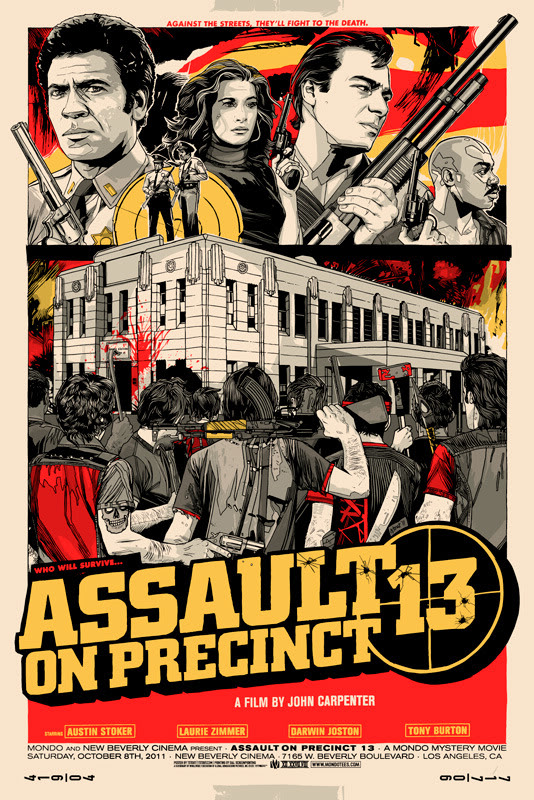 Welcome back to this eighteen-part series examining the theatrical movies of one John Carpenter, master genre auteur and gift to movie lovers everywhere. Today we bear witness to the director’s first foray into professional filmmaking, shooting on a schedule and a budget. It’s called Assault on Precinct 13, and I don’t mean to spoil this up front for you, but it is a-ma-zing.
Welcome back to this eighteen-part series examining the theatrical movies of one John Carpenter, master genre auteur and gift to movie lovers everywhere. Today we bear witness to the director’s first foray into professional filmmaking, shooting on a schedule and a budget. It’s called Assault on Precinct 13, and I don’t mean to spoil this up front for you, but it is a-ma-zing.
The Story
Precinct 9 (not actually 13) in the fictional South Central L.A. neighborhood of Anderson is due to shut down as its operations relocate. Newly promoted Lt. Ethan Bishop (Austin Stoker) receives the assignment of babysitting the meager staff staying overnight in the building for the final bits of housekeeping.
What should be a quiet evening detail goes bloodily wrong when the precinct turns into an epicenter of urban warfare. Heavily-armed multicultural gang Street Thunder targets civilians for death, but after they splatter-kill a little girl (Kim Richards), her enraged father Lawson (Martin West) shoots one of the gang warlords in retaliation. Fleeing Street Thunder’s fury, Lawson takes shelter in the precinct — unaware there isn’t much help available there. The gang descends on the building with the intent to massacre everyone inside. As Street Thunder’s legions crash in waves against the precinct, Lt. Bishop joins forces with two criminals in the holding cells, Napoleon Wilson (Darwin Joston) and Wells (Tony Burton), and station secretary Leigh (Laurie Zimmer) to attempt to survive the night until relief arrives.
The Positives
John Carpenter has a handful of cinematic masterpieces to his credit, and on only his second outing — his first professional production — he bags one. Although Dark Star has charm and shows an emerging talent, nothing in it prepares for the assurance and mastery on display in Assault on Precinct 13. John Carpenter directed the hell out of this movie, taking a laughable budget of $100,000 and a few weeks of shooting to create something glorious and perennial. It’s one of the finest movies of the director’s long career, and as smashing an action-thriller as anybody could make. Each time watching it is a jolt of how effective the art of cinema can be.
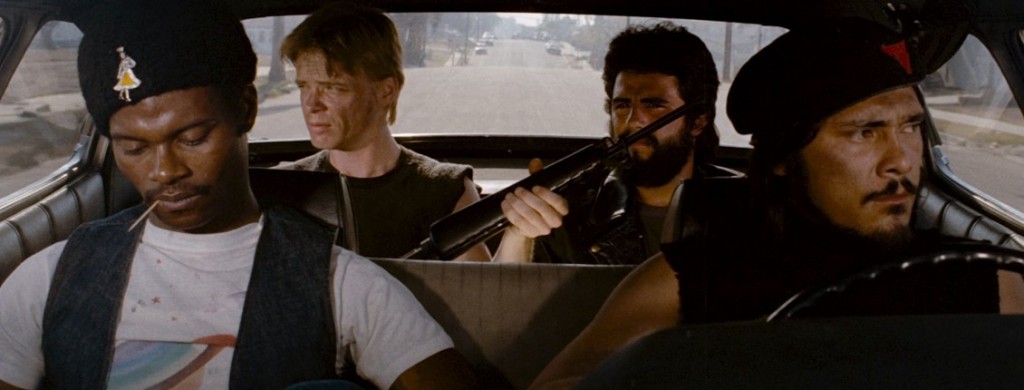 The true “action film” genre hadn’t completely evolved in 1976, although it was moving close. Assault on Precinct 13 has aspects of the action movie, but it’s primarily a suspense thriller that lays on breathless tension and pacing. The early section contains relaxed segments, such as taking a pause to watch Lt. Bishop walk from his house and get into his car. (Carpenter has admitted these long takes helped stretch the budget because they were quick to shoot and consumed screen time.) But Carpenter carefully constructs the tension during this part of the movie — before the story proper starts — intercutting three sequences on a collision course for the understaffed precinct: Street Thunder cruising for a civilian to snipe, Napoleon Wilson packed into a bus headed for Death Row, and Lawson and Kathy getting lost on their drive.
The true “action film” genre hadn’t completely evolved in 1976, although it was moving close. Assault on Precinct 13 has aspects of the action movie, but it’s primarily a suspense thriller that lays on breathless tension and pacing. The early section contains relaxed segments, such as taking a pause to watch Lt. Bishop walk from his house and get into his car. (Carpenter has admitted these long takes helped stretch the budget because they were quick to shoot and consumed screen time.) But Carpenter carefully constructs the tension during this part of the movie — before the story proper starts — intercutting three sequences on a collision course for the understaffed precinct: Street Thunder cruising for a civilian to snipe, Napoleon Wilson packed into a bus headed for Death Row, and Lawson and Kathy getting lost on their drive.
Once Lawson kills the White Warlord and the shooting starts, Assault on Precinct 13 turns into a lean, unrelenting thrill ride. When Street Thunder begins firing on the precinct, half of the occupants die immediately, which violently jacks up the stakes for the five people remaining. (Lawson doesn’t really count, since he’s catatonic the remainder of the running time.) The central attack set-piece, where the gang members smash through windows one after the other as the precinct defenders lay into them with dwindling ammo is as dynamite as this kind of sequence gets. The last stand in the basement, with Bishop trying to shoot an acetylene tank before the gang overwhelms them while Leigh plugs punks coming in through a vent, ends the film on one of its strongest notes.
Although originally targeted at the exploitation crowd, Assault on Precinct 13 is purposely scripted with the feeling of a 1940s melodrama. The dialogue replaces period slang with the crispness of a Warner Bros. gangster film. Lines like “You look like someone spit in your socks” or exchanges such as this:
Leigh: I’ve never had much faith in anyone coming to my rescue.
Napoleon Wilson: Maybe you’ve been associating with the wrong kind of people.
Leigh: I’ve worked with police officers for five years.
This didn’t help the movie play with the drive-in crowd — it made little impression in the U.S. on its first release — but carried it in Europe and makes it stand out today as sharp and timeless. There’s a joy in Classic Hollywood bubbling through everything, but with an edge of hunger from the fringe of New Hollywood. Rio Bravo meets Night of the Living Dead.
Carpenter’s adoration of Rio Bravo and its director Howard Hawks suffuses the characters and their working relationship, especially Leigh as the tough heroine and her “almost there” romance with Napoleon Wilson. But Carpenter’s goal wasn’t to re-make Rio Bravo. He took what he needed from his favorite movie (the basic plot structure, character dynamics, a number of tics like the shotgun toss and the “Got a smoke?” running gag) and crafted a unique shoot ‘em up. There’s copious material taken from Night of the Living Dead, Zulu, Fort Apache, Once Upon a Time in the West, and countless police noirs. But the final results belong to John Carpenter.
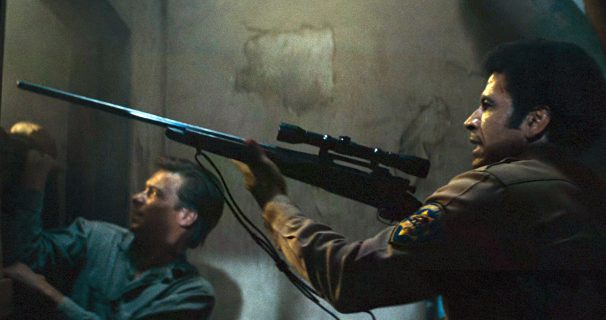 Lt. Ethan Bishop is the movie’s classic-style hero: a lawman who believes in his role as a protector, no matter what, but a man willing to improvise and ally with a criminal because he’s a smart judge of character. Bishop’s assignment to the Anderson precinct, which seems initially like a brush-off, takes him back to his origins. He was brought up in the Anderson ghetto, but pulled himself out of it — possibly escaping becoming something like the members of Street Thunder. He bristles slightly at Leigh’s suggestion that someone had to take him out of the ghetto: “No one took me out of Anderson. I walked out myself when I was twenty.”
Lt. Ethan Bishop is the movie’s classic-style hero: a lawman who believes in his role as a protector, no matter what, but a man willing to improvise and ally with a criminal because he’s a smart judge of character. Bishop’s assignment to the Anderson precinct, which seems initially like a brush-off, takes him back to his origins. He was brought up in the Anderson ghetto, but pulled himself out of it — possibly escaping becoming something like the members of Street Thunder. He bristles slightly at Leigh’s suggestion that someone had to take him out of the ghetto: “No one took me out of Anderson. I walked out myself when I was twenty.”
Bishop has two stellar moments. The first comes after the realization that the reason the precinct is under attack is because Street Thunder wants Lawson. Julie (Nancy Loomis), the switchboard operator who is justifiably terrified, suggests they surrender Lawson. Bishop refuses: “This is my station tonight. He came in here for help. He’s going to get all the help we can give him.” Bishop’s dedication to his role as protector connects back to his first scene, where he tells his CO over the radio that he wants to be a hero the first day on the new job. “There are no heroes anymore, Bishop,” the CO responds. “Only men who follow orders.” This turns out to be false: Bishop follows orders, protecting a man seeking help, and it makes him a hero.
The other fantastic moment for Bishop is the coda, where he refuses to let a cop handcuff Napoleon Wilson and instead offers the criminal the dignity of walking out of the precinct at his side. Austin Stoker kills it in these final minutes.
Napoleon Wilson is an archetypal example of the “good bad guy,” whose sense of loyalty to people he hardly knows in the face of danger overcomes our murky knowledge of his past crimes. (The most we’re told is that he killed some men, which was a big enough event to make him a familiar name to law enforcement.) But since criminals with codes of honor are a dime a dozen in crime dramas, Napoleon Wilson wouldn’t necessarily register as sympathetic based on this character sketch alone. It’s the charm of Darwin Joston’s performance that makes the sale. Joston was one of the great underused acting talents of the 1970s. The way he deadpans Wilson’s dry humor wins viewers over from the first, and he even makes somewhat corny lines like “I was born out of time” land perfectly.
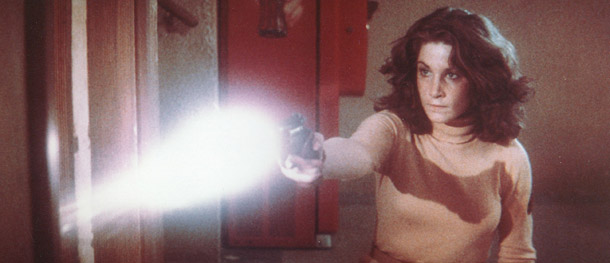 Stoker and Joston are both aces, but Assault on Precinct 13’s stunner of a performance belongs to Laurie Zimmer as Leigh. Smart, witty, capable, and unflappable (she takes a bullet to the arm and doesn’t flinch just so she can lure a gang member into an ambush), Leigh is both a classic “Hawksian” woman capable of holding her own with the male heroes and a perfect John Carpenter heroine. This is the type of female lead we still don’t see enough of in movies. The way she wordlessly refuses an ambulance stretcher at the finale and walks out of the precinct on her own is excellent character work. Zimmer also plays off Darwin Joston marvelously. Watching her finally provide the smoke and light Napoleon Wilson has been asking for the entire film is magical.
Stoker and Joston are both aces, but Assault on Precinct 13’s stunner of a performance belongs to Laurie Zimmer as Leigh. Smart, witty, capable, and unflappable (she takes a bullet to the arm and doesn’t flinch just so she can lure a gang member into an ambush), Leigh is both a classic “Hawksian” woman capable of holding her own with the male heroes and a perfect John Carpenter heroine. This is the type of female lead we still don’t see enough of in movies. The way she wordlessly refuses an ambulance stretcher at the finale and walks out of the precinct on her own is excellent character work. Zimmer also plays off Darwin Joston marvelously. Watching her finally provide the smoke and light Napoleon Wilson has been asking for the entire film is magical.
Kathy’s killing. The catalyst for the assault of the title, a classic “Holy sh—!” movie moment, a bit that almost got the film an “X” rating, and John Carpenter’s first claim to genre notoriety. Murdering a child on screen is a gutsy move: audiences sense it coming, but don’t think the film is actually going to do it — and not in a blunt splatter shot framed in the center of the screen to give everybody time to absorb that, yep, they actually did it.
The shockwaves of Kathy’s murder still strike hard: we imagine we’re immune to movies shocking us, and then here comes this splash of bloody business from forty years ago as a reminder of what it means to stun an audience. Adding an extra jolt is that the actress playing Kathy, Kim Richards, is nostalgically familiar to anyone who grew up watching Escape to Witch Mountain.
The death of Kathy reverberates in ways aside from motivating the central action. Bishop and the other precinct defenders don’t know Street Thunder murdered a kid — they never learn what made Lawson seek sanctuary — which gives the audience knowledge the characters don’t have. Bishop’s insistence on protecting Lawson no matter what appears brave and principled from the POV of the inside of the precinct. But it seems even more heroic to us because we know the horror that drove Lawson to this end.
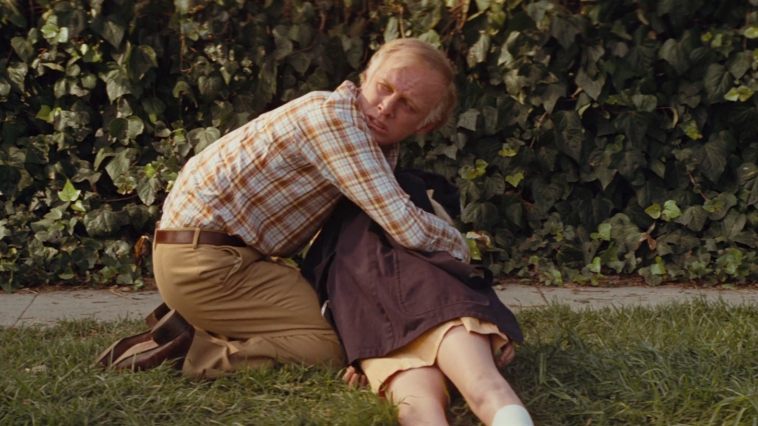 Kathy’s cruel demise also affects Napoleon Wilson’s character. Wilson is a confessed murderer who has embraced that he has “something to do with death.” (A line that’s a direct nod to Sergio Leone’s Once Upon a Time in the West.) But viewers know that whatever he did, it wasn’t as vile as casually shooting an innocent twelve-year-old girl in the chest. So Napoleon Wilson’s actually an okay guy … or at least we’re willing to treat him that way during the siege.
Kathy’s cruel demise also affects Napoleon Wilson’s character. Wilson is a confessed murderer who has embraced that he has “something to do with death.” (A line that’s a direct nod to Sergio Leone’s Once Upon a Time in the West.) But viewers know that whatever he did, it wasn’t as vile as casually shooting an innocent twelve-year-old girl in the chest. So Napoleon Wilson’s actually an okay guy … or at least we’re willing to treat him that way during the siege.
The slaying of Kathy ties into another powerful aspect of Assault on Precinct 13: the near-supernatural malevolence of the gang members. The movie makes zero attempt to grapple with the juvenile hoodlums realistically, and Carpenter shows no interest in social issues about gang violence. This isn’t a modern L.A. street gang, but a mash-up of George Romero zombies and Hollywood Apaches. Street Thunder’s members swarm and move in disciplined groups, operate without making noise (even when shot or bashed in the face with a crowbar), and except for a few utterances in the opening scenes, speak no dialogue at all. They’re an unreasoning yet cunning force. When a gang member pops up in the backseat of a car to shoot Wells during his attempt at a getaway, it’s easy to believe that the gang had a sixth sense that told them to hide a shooter in that specific car.
A low budget doesn’t have to prevent a movie from looking fantastic. Carpenter and cinematographer Douglas Knapp have a mastery of the widescreen frame that raises a “cheapie” to shine like a prestige picture. Every shot in Assault on Precinct 13 teaches a lesson in composition. It isn’t ostentatious photography hunting for an Oscar; it’s simply the right kind of photography to draw viewers into the action and give the picture an expansive look.
One of my favorite examples of the widescreen compositions is a shot of Lawson’s Chevy pursuing Street Thunder’s car. The camera shoots the scene head-on from a rig attached to the first car and puts the headlights of the second car swerving behind it, with the bloody streaks of sundown as a backdrop. It’s a kinetic and beautiful image, but also serves a number of story functions: it marks the transition from day to night, shows Lawson’s obsession, and creates the momentum for when Lawson guns down the White Warlord — the action that ignites the siege. Smart shot compositions such as this are the norm in Assault on Precinct 13.
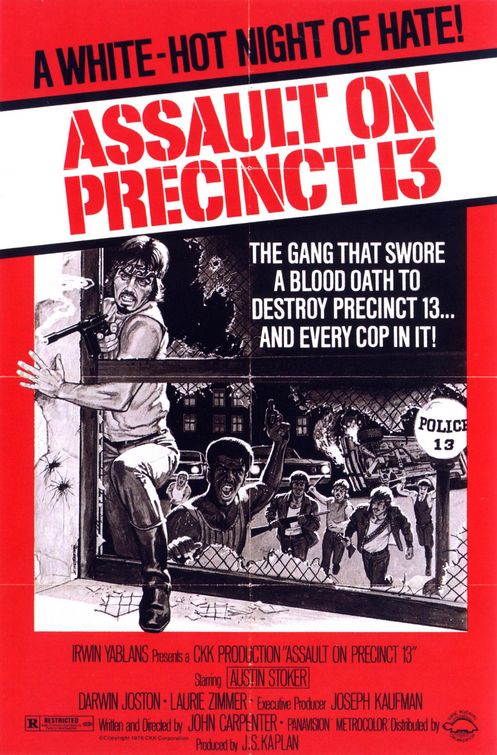 Props also to production designer Tommy Wallace, one of Carpenter’s early collaborators, for enhancing the movie’s appearance. The interior of the precinct looks like it was shot on location, rather than in a soundstage on Melrose. Just the smudges on the walls add a layer of authenticity. The movie in general creates an excellent sense of place and geography out of its disparate shooting locations. The parking lot across from the precinct building where the gang members use trees for cover is located in North Hollywood, on the other side of Los Angeles from Venice, where the exterior of the precinct was photographed.
Props also to production designer Tommy Wallace, one of Carpenter’s early collaborators, for enhancing the movie’s appearance. The interior of the precinct looks like it was shot on location, rather than in a soundstage on Melrose. Just the smudges on the walls add a layer of authenticity. The movie in general creates an excellent sense of place and geography out of its disparate shooting locations. The parking lot across from the precinct building where the gang members use trees for cover is located in North Hollywood, on the other side of Los Angeles from Venice, where the exterior of the precinct was photographed.
Although Carpenter has many great scores ahead of him, I don’t think he ever topped his music here. The pounding energy of the main title and the mournful “precinct theme” (an homage to Jerry Goldsmith’s theme for Howard Hawks’s Rio Lobo) are superb. It’s Carpenter at its purest … like everything else in the movie.
The Negatives
When I devised the idea of traveling through the complete John Carpenter filmography using the “what’s good/what’s bad” review style from Joshua Miller’s popular “Franchise Me” series (I wish he’d return to writing it), I realized I’d have problems with a number of Carpenter’s finest movies. Namely, there’s almost nothing negative to say about them. I’m already facing this dilemma on only the second movie — and worse is coming up. What am I going to do about The Thing?
The main obstacle standing in the way of Assault on Precinct 13 is the budget, which the movie makes work in its favor in nearly every situation. A multi-ethnic youth gang is a ridiculous concept on the surface, but the unreal way the movie treats Street Thunder turns this into another piece of weirdness about the gang. Is it incredibly unlikely that a police precinct in Los Angeles could come under an armed siege without the rest of the city noticing? Of course, but I doubt anyone watching the movie cares. I don’t.
Laurie Zimmer should have gone on to a solid acting career based on her performance here. However, she chose to retire from the industry in 1979 after only a few more roles. She was later the subject of a French documentary, Do You Remember Laurie Zimmer?, where one of her former directors tries to track her down and eventually finds her working as a teacher in San Francisco. Zimmer’s exit from acting isn’t a negative about Assault on Precinct 13, but a loss for movies in general. Look, that’s all I’ve got.
The Pessimistic Carpenter Ending
Our three protagonists survive the night and walk out, but Napoleon Wilson is still headed to Death Row. Everyone else in the precinct perishes (seven in total), and nothing is bringing young Kathy back from the dead. Street Thunder remains active, probably still cruising the streets with high-powered rifles and shooting kids who like vanilla twist ice cream.
Next: Something called Halloween. Probably a kids’ film.
Ryan Harvey is one of the original bloggers for Black Gate, starting in 2008. He received the Writers of the Future Award for his short story “An Acolyte of Black Spires,” and his stories “The Sorrowless Thief” and “Stand at Dubun-Geb” are available in Black Gate online fiction. A further Ahn-Tarqa adventure, “Farewell to Tyrn”, is currently available as an e-book. Ryan lives in Costa Mesa, California where he works as a professional writer for a marketing company. Occasionally, people ask him to talk about Godzilla in interviews.
Unfortunately, almost right out of today’s newspaper stories. I saw this on TV, and think it may have been edited. It didn’t grab me, I’m afraid, but after reading your review I’m tempted to watch it again.
Great review, Ryan! As far as the multiculti street gang and the seeming isolation of the precinct, I have always chalked it up to mythic storytelling masquerading as an exploitation film. Walter Hill did the same thing with THE WARRIORS. This is Thor and Loki fighting their way out of Jotunheim or Orpheous having a much rougher walk out of Hades. Last stands stir the blood. ZULU and ALIENS are both mythic, the latter derived from the former, IMO.
BTW, word is Carpenter named Zimmer’s character “Leigh” in homage to Leigh Brackett. Props to the man for that.
@deuce – The Mythic aspect is definitely there. I think it comes from Carpenter’s adoration of the Western, which is very much American mythology, our version of Arthurian legends. Carpenter never cared for realism in his movies, unless that realism could serve, as in Assault on Precinct 13, as the canvas for his favorite type of archetypal storytelling.
I’m 100% certain Leigh is named after Leigh Brackett; she wrote the script for Rio Bravo after all!
Edit: The sheriff in Halloween played by Charles Cyphers (Special Officer Starker in Assault on Precinct 13) is named Sheriff Leigh Bracket—just so Carpenter could be absolutely clear.
Carpenter is one of those directors who seem to make better movies when given a lower budget. M. Night seems to fall into this category as well. I’m looking forward to the rest of this series.
And speaking of the precinct’s isolation, it’s remarkable how well Carpenter is able to create that illusion, because the actual exterior shooting location on North Venice Blvd. in Venice, CA. is anything but isolated. Here’s a picture of it today:
You can see there’s another building the same age pressed right up against it. This is the general layout of Venice: it’s a dense neighborhood. But you’d think the precinct was in the middle of nowhere, surrounded with empty lots for as far as the eye can see, based on the shooting and editing in the movie.
Today the precinct is the Social and Public Art Resource Center, dedicated to Los Angeles’s long history of street mural art. It was abandoned during the period when the movie was shot, and was formerly the Venice Police and Fire Station.
Thanks for giving well-deserved props to this bad-ass classic.
Napoleon: “There are two things a man should never run from, even if they cost him his life. One is a man who’s helpless and can’t run with you.”
Leigh: “What’s the other?”
Napoleon: *just looks*
My wife thinks Joston as Napoleon is remarkably charming 🙂 I once watched this with my mom, though, and she hated it because she didn’t buy anything about the Lawson character. I wonder if she might feel differently if she watched it again.
The funny thing about Carpenter’s music is that he’s said he composes in a minimalist style because he wants the music to fade into the background. However, if you compare his music to today’s modern scores that really are just shapeless background mood noises, his music is incredibly catchy and memorable. I enjoy both of his recent solo albums, too.
I didn’t find a place to put this in the essay, but here is my favorite humorous exchange from the movie:
[…] image source by blackgate […]